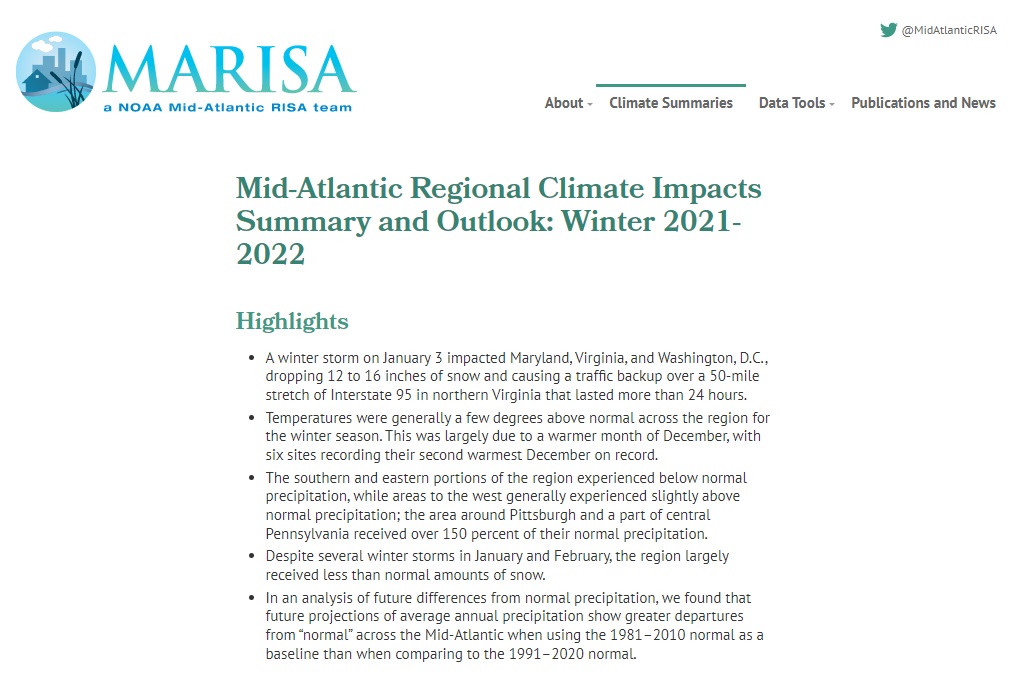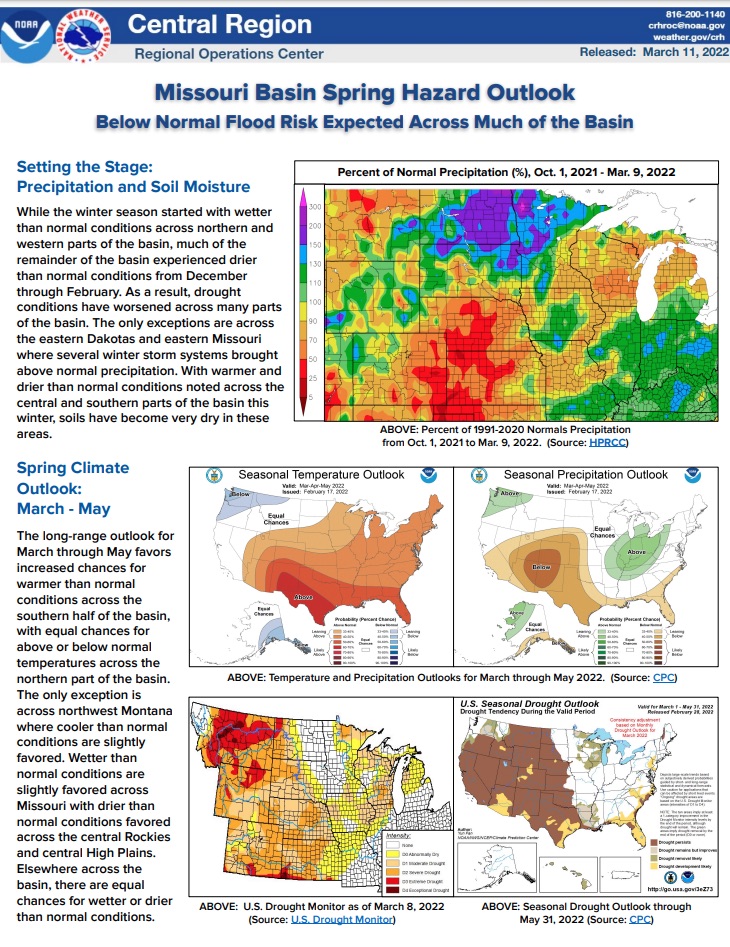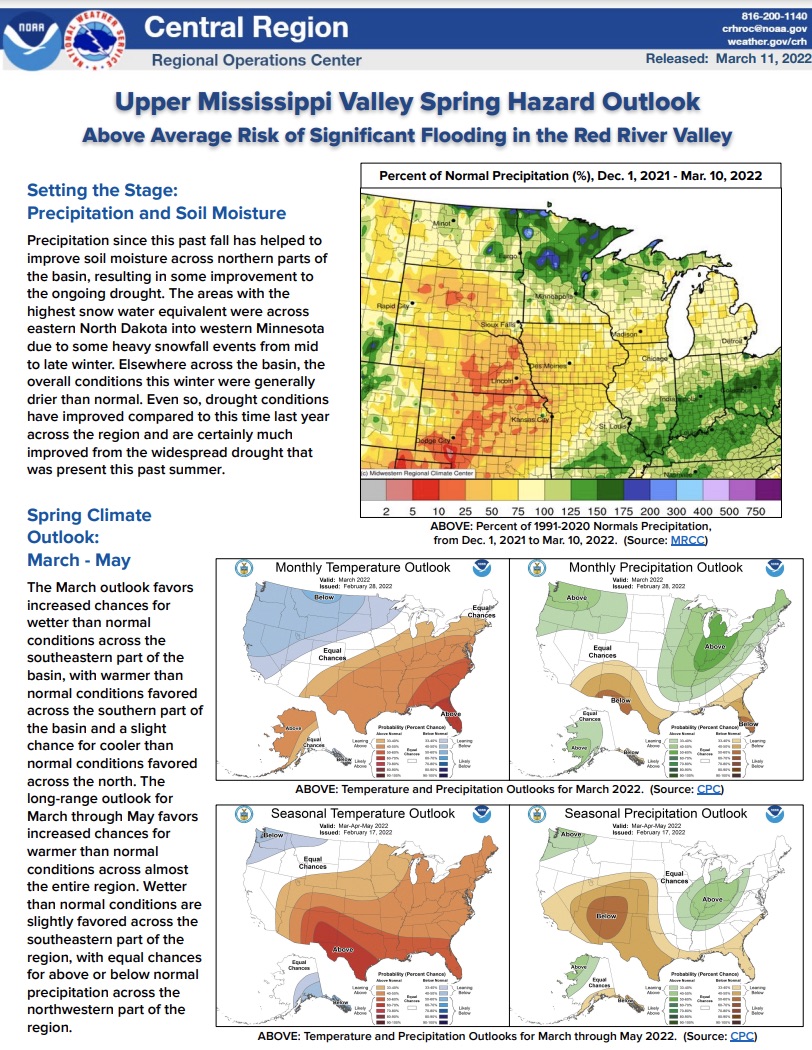Quarterly Climate Impacts and Outlook for the Mid-Atlantic Region for December 2021 - February 2022. Dated March 2022.
Temperatures were generally a few degrees above normal across the region for the winter season. This was largely due to a warmer month of December, with six sites recording their second warmest December on record. The southern and eastern portions of the region experienced below normal precipitation, while areas to the west generally experienced slightly above normal precipitation.
Quarterly Climate Impacts and Outlook for the Midwest Region for December 2021 - February 2022. Dated March 2022.
Quarterly Climate Impacts and Outlook for the Northeast Region for December 2021 - February 2022. Dated March 2022.
The Northeast's winter average temperature was 0.7°F above normal, ranking in the warmest third of all years. Six states had one of their 20 warmest winters. The Northeast saw 88% of normal winter precipitation, ranking in the middle third of all years. This winter was among the 20 driest for four states.
Quarterly Climate Impacts and Outlook for the Missouri River Basin for December 2021–February 2022. Dated March 2022.
Winter temperatures were above normal for the majority of the Missouri River Basin. Precipitation was mostly below normal in the mountains and plains. The exception was eastern North Dakota with well-above-normal precipitation and snowfall. Many counties in northern Kansas and Nebraska ranked among their driest winters on record.
Quarterly Climate Impacts and Outlook for the Pacific Region for December 2021–February 2022. Dated March 2022.
For the December–February period, precipitation was below normal in Guam, areas of Federated States of Micronesia (FSM), and in northern Republic of the Marshall Islands. Conversely, near- to above-normal rainfall was observed in Palau, Saipan, western/southern FSM, and in American Samoa. In early December, a kona low brought very wet conditions to the Hawaiian Islands before transitioning to abnormally dry conditions in January and February.
The National Weather Service developed 2022 Spring Hazard Outlooks in coordination with NOAA's National Centers for Environmental Information (NCEI) and National Integrated Drought Information System (NIDIS); High Plains Regional Climate Center; Midwestern Regional Climate Center; U.S. Department of Agriculture; and National Interagency Fire Centers' Geographic Area Coordination Centers. This outlook highlights the various spring hazards that could occur and potential impacts across the Ohio River Valley.
The National Weather Service developed 2022 Spring Hazard Outlooks in coordination with NOAA's National Centers for Environmental Information (NCEI) and National Integrated Drought Information System (NIDIS); High Plains Regional Climate Center; Midwestern Regional Climate Center; U.S. Department of Agriculture; and National Interagency Fire Centers' Geographic Area Coordination Centers. This outlook highlights the various spring hazards that could occur and potential impacts across the Missouri River Basin.
The National Weather Service Central Region developed 2022 Spring Hazard Outlooks in coordination with NOAA's National Centers for Environmental Information and National Integrated Drought Information System (NIDIS); U.S. Department of Agriculture; High Plains Regional Climate Center; Midwestern Regional Climate Center; and National Interagency Fire Center's Geographic Area Coordination Centers. This outlook highlights the various spring hazards that could occur and potential impacts across the Upper Mississippi Valley.
The National Weather Service developed 2022 Spring Hazard Outlooks in coordination with NOAA's National Centers for Environmental Information (NCEI) and National Integrated Drought Information System (NIDIS); High Plains Regional Climate Center; Midwestern Regional Climate Center; U.S. Department of Agriculture; and National Interagency Fire Centers' Geographic Area Coordination Centers. This outlook highlights the various spring hazards that could occur and potential impacts across the Mountain West.
Quarterly Climate Impacts and Outlook for the Missouri River Basin September - November 2021. Dated December 2021.
Temperatures remained much above normal across the entire Missouri River Basin. These above normal temperatures resulted in all the states within the Missouri River Basin ranking in the top 10 warmest falls on record. Precipitation this fall varied with most of the region observing below normal precipitation aside from the Northeast and Kansas.











